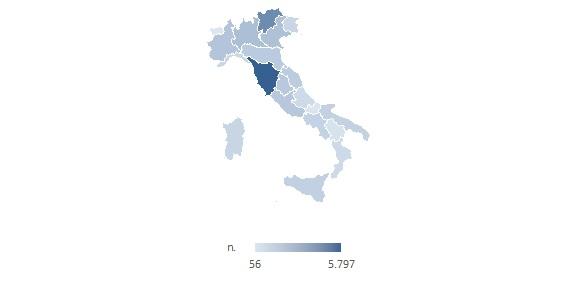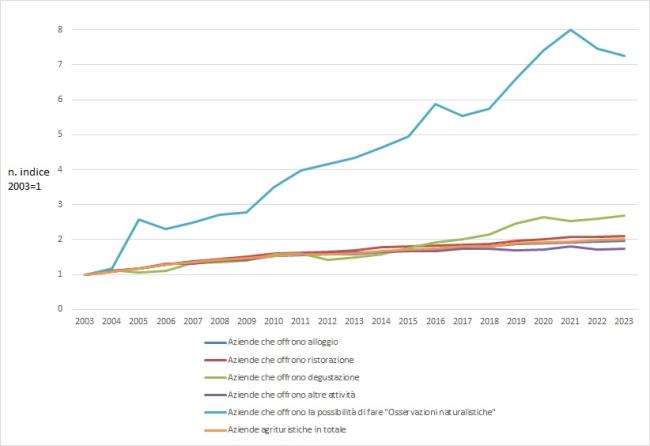Panel 1
Giovanni Finocchiaro, Silvia Iaccarino
The indicator monitors the spread of agritourism, a form of tourism integrated into the local territory that helps reduce the impact of infrastructure on biodiversity and the landscape. Between 2003 and 2023, the sector recorded a 101% increase, growing from 13,000 to over 26,000 agritourism businesses. Facilities offering accommodation rose by 97%. Furthermore, "green" activities—especially nature observation—experienced significant growth.
The indicator reports the number of agritourisms, examining their composition, the number of beds, and the agritourism activities offered. Agritourism refers to the provision of hospitality by a farm that has obtained the necessary authorization and adapted its facilities to carry out such activities.
Quantifying the presence of farmhouses as a form of integrated tourism activity in the area, aimed at reducing the "weight" of infrastructure on biodiversity and the landscape. Furthermore, the tourist activities offered (hiking, horseback riding, cycling) can provide a measure of the systems adopted to minimize the impact of transportation methods.
"National agritourism law" enacted on February 20, 2006, and published in Official Gazette No. 63 on March 16, 2006.
Panel 2
ISTAT – Statistiche report – Le aziende agrituristiche in Italia. Anno 2022
ISMEA, Rapporto, Agriturismo e multifunzionalità. Scenario e prospettive, dicembre 2022
No data are available on the means of soft mobility available to guests.
Data quality assessment
ISTAT (National Institute of Statistics)
National, Regional
2003-2023
Indicator assessment
Simple calculation operations.
In 2023, the number of authorized agritourism companies reached 26,129 units, an increase of 1.1% compared to the previous year. 81% of companies offer accommodation services, while 36% combine accommodation and catering (Table 1 and Table 3). The geographical distribution confirms a greater concentration in the regions of Tuscany and Trentino-Alto Adige, in particular in the autonomous province of Bolzano. Between 2022 and 2023, Valle d'Aosta, Liguria and Abruzzo recorded the largest declines in terms of the number of agritourism companies.
From 2003 to 2023, the agritourism sector shows constant growth, with a 101% increase in the number of companies. Accommodation facilities increased by 97%, agri-refreshments by 110%, while wineries with tastings more than doubled, from 2,500 to over 6,500 units (Table 1). Nature observation activities have grown from 224 in 2003 to 1,627 in 2023, highlighting a strong interest in experiences in contact with nature.
Data
Table 1: Agritourism farms by type of activity*
ISPRA elaboration on ISTAT data
* A farm may be authorized to carry out one or more types of agritourism activities
Table 2: Agritourism farms by kind of service provided*
ISPRA elaboration on ISTAT data
* A farm may be authorized to carry out one or more types of agritourism activities
Table 3: Agritourism farms by type of accommodation (2023)
ISTAT
(*) A farm may be authorized to carry out one or more types of agritourism activities
Table 4: Agritourism farms* by type of additional activity (2023)
ISTAT
(*) A farm may be authorized to carry out one or more types of agritourism activities
(**) Educational farms aim to bring farmers, their farms, and their products closer to an audience of adults and children interested in discovering and experiencing first-hand a way of life that has long preserved the rural environment. Educational farms are an expression of the multifunctionality of agricultural enterprises and are fully included among the recreational, cultural, and educational activities carried out by agritourism farms


Agritourism continues to represent an element of strength of Italian agricultural multifunctionality, combining tradition and innovation in a model of sustainable development. The growing interest in experiential services and soft mobility has favored a diversification of the offer. In 2023, the companies authorized to provide accommodation reached 21,163 units, equal to 81% of the national total, with over 302,000 beds (+1.9% compared to 2022) and more than 14,800 pitches for agri-camping.
At the regional level, the most significant growth was recorded in Sardinia (+3.5%) and Lazio (+3.3%), while in seven regions there was a contraction (Table 2 – Figure 1). Trentino-Alto Adige and Tuscany have the highest incidence of farmhouses with accommodation only (27%), while the "accommodation and catering" formula is more widespread in Tuscany (20%) (Table 3).
In 2023, 12,973 companies offer complementary activities, with a strong presence of excursions in Sicily and Trentino-Alto Adige and mountain bike routes in Piedmont and Tuscany. About 4,800 farms offer courses, trekking and horseback riding, while 1,627 farmhouses offer nature observation experiences. In addition, 2,085 farmhouses carry out educational farm activities, with particular diffusion in Piedmont and Lombardy. Emilia-Romagna and Veneto (Table 4).